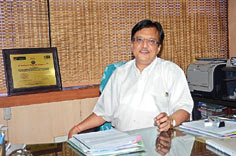We need to perform all the time or we perish - SS Mantha, Chairman, AICTE
 Technical education in India contributes a major share to the overall education system and plays a vital role in the social and economic development of our nation. In India, technical education is imparted at various levels such as craftsmanship, diploma, degree, post-graduate and research in specialized fields, catering to various aspects of technological development and economic progress.
Technical education in India contributes a major share to the overall education system and plays a vital role in the social and economic development of our nation. In India, technical education is imparted at various levels such as craftsmanship, diploma, degree, post-graduate and research in specialized fields, catering to various aspects of technological development and economic progress.
20% of the seats remain vacant…
The current enrolment for engineering education is 1.7 millions. About 20% of the seats remain vacant. However, it is also a fact that 93% of the institutions are in the private sector. When an institution is set-up in the private sector, the land and infrastructure belongs to private entrepreneur. Thus entrepreneur while following all the regulations of AICTE for setting up such institutions cannot be denied a promotion to do so since the Indian constitution under section 19 (g) of Fundamental Rights provide for practice of a profession that he or she chooses to follow. Hence, a growth in the private sector happens.
20 million or 50% of students drop out from the higher education sector currently and there is no means for them to pursue higher education any further. Hence, while considering that only 50% of the students eventually make the grade. We need many more institutions to come up to provide education and a means for livelihood.
AICTE initiatives to improve quality
However, to improve quality, AICTE has several initiatives and actively promotes industry collaborations and industry participation. AICTE provides funds for improving infrastructure and laboratories in these institutions.
Further, we at AICTE approve conduct of PG programs in the second shift that will enable our full time teachers to pursue PG education in the second shift. Additionally, we have approved several more quality improvement centers in Government and Government aided Institutions so that the faculty can pursue Ph D programs.
We would also select 50 Institutions on a normative basis and allow local industries to set up their research centers in these institutions. This, we believe, would help faculty students and industry to interact, create new knowledge, and improve quality in our institutions.
Surprise inspections of institutions
The institutions today follow a process of self-disclosure wherein they upload all data pertaining to their institutions in a self-disclosure mode. Further they submit an affidavit for the correctness of the data uploaded. The regulations provide for civil as well as criminal proceedings. Hence, the institutions not only give correct data but also implement several initiatives to improve quality.
AICTE further has surprise inspections of institutions to allow them to follow all quality measures. Last year AICTE inspected more than 500 institutions and levied penal action on more than 250 of them.
Popular branches
Popular fields of study at the undergraduate level today are Electronics, Communications, Computers, Mechanical, Electrical, Civil, IT and so on. However we need to understand that Technology today is inter-disciplinary and multi-disciplinary and the curriculum provides for this in many universities along with very good basics and conceptual grounding. Hence our students excel in diverse environments. Typically Computers and IT allow employment for almost all specializations.
New choices
Though classical branches of engineering like Mechanical, Electrical and Civil still hold sway over others, the interdisciplinary and multi disciplinary areas like Nanotechnology- engineering at the molecular, atomic and subatomic level, Audio/visual engineering- dealing with sound and vision, Mechatronics - combining mechanical, electrical and software engineering, Aerospace engineering or even Nuclear engineering are some new choices that students could explore.
Grievance mechanism for complaints
A student can approach AICTE through the Grievance mechanism available on the AICTE portal. One can file an online grievance at www.aicte-india.org>grievance. There are various categories under which he/she can make a complaint. Every college needs to establish a Grievance cell and the University an Ombudsman.
AICTE has recently notified regulation 2012 for mandatory establishment of Ombudsman and Grievance Cell in all institutions. A student can approach these for redressal of their problems. Students can also write directly to us so we can take an immediate action.
Colleges’ information in AICTE website
The AICTE webpage www.aicte-india.org>Departments>approvals discloses the college infrastructure, land, fund details, students, faculties, etc. thereby helping only the genuine education promoters establish institutes or expand their current operations. The feature of making available information of all Institutions in the public domain has doubly enhanced the public perception that AICTE is truly on a reformist path.
Teaching – learning criteria
The strength and character of undergraduate programs in technology is in Mathematics, Physics and the various fields of science, which will be recognized as primary indicators of the quality of a college or university. Hence, making requisite capital investments in faculty and facilities are essential steps to achieving institutional distinction.
Probably an integrated planning approach, linking academic planning, campus planning and budgetary planning, in ways that reflect the institutional mission and vision, using budget as a planning tool is a good idea.
AICTE is in the process of issuing regulations for mandatory accreditation. Institutions that do not meet the teaching – learning criteria would be dealt within the provisions of the regulations.
Curriculum design
Within the curriculum as practiced in the Universities, 80% is core subject requirement and the remaining 20% is a value added curriculum content. This content plays an extremely important part in developing a student outlook of life.
The industry experts need to play an active role in the development of content and also provide contemporary material in the form of experimental results, research material and so on.
Industry also needs to provide internship to students so that general quality and job experience can be provided to the students.
The curriculum designed should contain the best practices as practiced elsewhere in the world along with a massive implementation of ICT.
Industry-academia interaction
MHRD and AICTE are actively pursuing industry collaboration for improving quality in their institutions. We have conducted several workshops with industry leaders in the past one year where sector-wise representatives were involved and several good ideas have evolved.
With CII, AICTE has also conducted survey amongst its institutions for the best interaction case study with the industry and even awarded such institutions. It is now in the process of conduct such another survey. Industry is also being actively engaged to support, establish and even adopt the existing institutions for a better quality.
We are also encouraging industries with over Rs. 100 cr turnover to set up institutions. PPP models are also being explored.
IT curriculum oversees all the specializations
The typical content of an IT program curriculum includes 40% of Computer Science, 40% of Electronic and Communication and about 20% of application area. Hence, IT curriculum oversees all the specializations in its application areas.
IT professionals will be able to develop applications for value added propositions for any industry. Hence, it is also felt that such programmes add to the value of other disciplines. Hence, I do not think professionals with other specialization would be wasted in an IT or ITES job. If at all any thing, it would only add to the value of other disciplines.
Net increase in both number of institutions and number of seats
According to the Industry bodies, about 340 business schools are in the process of either winding down or have already shut shop since 2012. Last year alone, 180 B-schools went out of business and another 160 are likely to shut shop this year, the report said. The MBA education bubble - fueled by tales of multi-crore fresher salary packages - is bursting.
However, the statistics generated from AICTE e-Governance data shows that in the year 2011 – 2012, 124 institutions closed and 146 new institutions were give approval. This translated into 5602 seats reducing and 14340 seats adding to the total number of seats.
In 2012 – 13, 101 institutions closed and 82 new institutions were given approval. This translated into 6090 seats reducing and 7740 seats adding to the total number of seats.
Hence, it is seen that there is a net increase in both number of institutions and number of seats in the system. This clearly shows that the MBA education bubble bursting as reported by the industry bodies is not true and hence MBA is not seen to be losing its sheen.
There are 3792 Management Institutions and more than 3500 engineering schools in the country approved by the AICTE with a total intake capacity of 4.3 laks in 2012-13 in management and 1.7 million in the engineering sector.
The statement of only 10 percent of students graduating from business schools in the country are getting jobs every year does not appear to be appropriate. It is informed that roughly 3.5 lacs students enroll to the Management schools in AICTE approved institutions every year.
Distance education for technical programmes
AICTE is currently in the process of developing standards and regulations for the conduct of some technical education programs in distance learning mode or hybrid or blended mode.
However, distance education needs to be monitored for quality and needs to be implemented in highly calibrated manner. ICT available should be deployed in massive way for the conduct of such programs.
Vocational Education Framework
AICTE has developed a scheme for Vocational Education where a student can learn competency based skills along with general education in seven certificate levels starting from 9th class going all the way up to graduate level. A student in this mode will be able to study for a Diploma or a Degree in Vocational education along with acquiring skills. The most important feature is that the student can also avail of multi point entry and exit between Formal or vocational education or the job market.
Advice to aspiring engineers
Engineering is a means for good living. Not the end. Values are very important in life and compassion for others is as important as breathing for life. Above all the education that we have should teach us to be good citizens. Remember you are the blessed one of a billion people.
The world today is extremely complex. We need to perform all the time or we perish. The point of the logic is contained in a thought from Africa, “Every morning in Africa, a gazelle wakes up. It knows it must outrun the fastest lion or it will be killed. Every morning in Africa, a lion wakes up. It knows it must run faster than the slowest gazelle, or it will starve. It doesn’t matter whether you’re a lion or gazelle - when the sun comes up, you’d better be running.”








